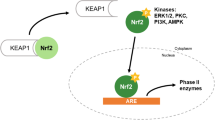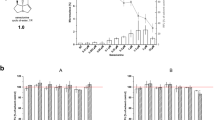Abstract
Quinone reductase (QR) is a protective phase II enzyme against mutagens and carcinogens which is inducible by a number of chemical compounds in plants. This study was carried out to investigate effects of the fractions from the seeds of Psoralea corylifolia on the induction of QR with Hepa 1c1c7 murine hepatoma cell line. The ethyl acetate-soluble fraction of the methanolic extract from the seeds was found to induce QR and the concentration of 1.5 fold QR induction (1.5 FIC) was 1.2 μg/mL. We obtained as an active compound, psoralidin, isolated from the ethyl acetate-soluble fraction after further sequential fractionation with column chromatography and 1.5 FIC of psoralidin was 0.5 μg/mL. The seeds of Psoralea corylifolia and psoralidin might be a candidate for developing QR inducers.
Similar content being viewed by others
References
Arora, A., Nair, M. G., and Strasburg, G. M., Antioxidant activities of isoflavones and their biological metabolites in a liposomal system. Arch. Biochem. Biophys., 356(2), 133–141 (1998).
Bayney, R. M., Rodkey, J. A., Bennett, C. D., Lu, A. Y. H., and Pickett, C. B., Rat liver NAD(P)H: quinone reductase nucleotide sequence analysis of a quinone reductase cDNA clone and prediction of the amino acid sequence of the corresponding protein. J. Biol. Chem., 262(2), 572–575 (1987).
Chen, H. H., Ma, J. X., Forrest, G. L., Deng, P. S. K., Martino, P. A., Lee, T. D., and Chen, S., Expression of rat liver NAD(P)H: quinone-acceptor oxidoreductase in Escherichia coli and mutagenesis in vitro at Arg-177. J. Biochem., 284, 855–860 (1992).
Chino M., Sato, K., Yamazaki, T., and Maitani, T. Constituent of natural food additive hokosshi extract and an analytical method for the additive in foods. Shokuhin Eiseigaku Zasshi, 43, 352–355 (2002).
Dicker, E. and Cederbaum, A. I., Requirement for iron for the production of hydroxyl radicals by rat liver quinone reductase. J. Pharmacol. Exp. Ther., 266(3), 1282–1290(1993).
Forrest, G. L., Qian, J., Ma, J. X., Kaplan W. D., Akman, S., Doroshow, J., and Chen, S., Rat liver NAD(P)H: quinone oxidoreductase: cDNA expression and site-directed mutagenesis. Biochem. Biophys. Res. Commun., 169, 1087–1093 (1990).
Gerhauser, C., Mar, W., Lee, S. K., Suh, N., Luo, Y., Kosmeder, J., Luyengi, L., Fong, H. H., Kinghorn, A. D., Moriarty, R. M., Mehta, R. G., Constantinou, A., Moon, R. C., and Pezzuto, J. M., Rotenoids mediate potent cancer chemopreventive activity through transcriptional regulation of ornithine decarboxylase. Nat. Med., 1, 260–266 (1995).
Khatune, N. A., Islam, M. E., Haque, M. E., Khondkar, P., and Rahman, M. M., Antibacterial compounds fro the seeds of Psoralea corylifolia. Fitoterapia, 75, 228–230 (2004).
Latha, P. G., Evans, D. A., Panikkar, K. R., and Jayavardhanan, K. K., Immunomodulatory and antitumour properties of Psoralea corylifolia seeds. Fitoterapia, 71, 223–231 (2000).
Lind, C., Relationship between the rate of reduction of benzo(a)pyrene-3,6-quinone and the formation of benzo(a) pyrene-3,6-quinol glucuronides in rat liver microsomes. Biochem. Pharmacol., 34, 895–897 (1985).
Mar, W., Je, K. H., and Seo, E. K., Cytotoxic constituents of Psoralea corylifolia. Arch. Pharm. Res., 24. 211–213 (2001).
Maxuitenko, Y. Y., Curphey, T. J., Kensler, H. W., and Roebuck, B. D., Protection against aflatoxin B1-induced hepatic toxicity as a short term screen of cancer chemopreventive dithiolethiones. Fundam. Appl. Toxicol., 32, 250–259 (1996).
Merk, H., Jugert, F., Bonnekoh, B., and Mahrle, G., Induction and Inhibition of NAD(P)H: Quinone Reductase in Murine and Human Skin. Skin Pharmacol., 4, 183–190 (1991).
Prestera, T., Holtzclaw, W. D., Zhang, Y., and Talalay, P., Chemical and molecular regulation of enzymes that detoxify carcinogens. Proc. Natl. Acad. Sci. USA, 90, 2965–2969 (1993).
Prochaska H. J., De Long, M. J., and Talalay, P., On the mechanisms of induction of cancer-protective enzymes: A unifying proposal. Proc. Natl. Acad. Sci. USA, 82, 8232–8236 (1985).
Prochaska, H. J. and Santamaria, A. B., Direct measurement of NAD(P)H: quinone reductase from cells cultured in microtiter wells: a screening assay for anticarcinogenic enzyme inducers. Anal. Biochem., 169, 328–336 (1988).
Prochaska, H. J. and Talalay, P., Regulatory mechanisms of monofunctional and biofunctional anticarcinogenic enzyme inducers in murine liver. Cancer Res., 48, 4776–4782 (1988).
Qiao, C. F., Han, Q. B., Mo, S. F., Song, J. Z., Xu, L. J., Chen, S. L., Yang, D. J., Kong, L. D., Kung, H. F., and Xu, H. X., Psoralenoside and isopsoralenoside, two new benzofuran glycosides from Psoralea corylifolia. Chem. Pharm. Bull. (Tokyo). 54, 714–716 (2006).
Ren, S. and Lien, E. J., Natural products and their derivatives as cancer chemopreventive agents. Prog Drug Res., 48, 147–171 (1997).
Sporn, M. B. and Newton, D. L., Chemoprevention of cancer with retinoids. Fed. Proc., 38, 2528–2534, (1979).
Talalay, P. and Benson, A. M., Elevation of quinone reductase activity by anticarcinogenic antioxidants. Adv. Enzyme Regul., 20, 287–300 (1982).
Talalay, P., Fahey, J. W., Holtzclaw, W. D., Prestera, T., and Zhang, Y., Chemoprotection against cancer by phase II enzyme induction. Toxicology Letters, 82–83, 173–179 (1995).
Tanaka, T., Makita H., Kawabata, K., Mori, H., Kakumoto, M., Satoh, K., Hara, A., Sumida, T., Tanaka, T., and Ogawa, H., Chemoprevention of azoxymethane-induced rat colon carcinogenesis by the naturally occurring flavonoids, diosmin and hesperidin. Carcinogenesis, 18(5), 957–965 (1997).
Wattenberg, L. W. and Lam, L. K., Inhibition of chemical carcinogen-induced neoplasia by coumarins and α-angelicalactone. Cancer Res., 39, 1651–1654 (1979).
Wattenberg, L. W. and Leong, J. L., Inhibition of the carcinogenic action of 7,12-dimethylbenz(α) anthracene by β-naphthoflavone. Proc. Soc. Exp. Biol. Med., 129, 940–943 (1968).
Wattenberg, L. W. and Leong, L. L., Inhibition of the carcinogenic action of benzo(α) pyrene by flavones. Cancer Res., 30, 1922–1925 (1970).
Wattenberg, L. W. and Loub, W. D., Inhibition of polycyclic hydrocarbon-induced neoplasia by naturally-occurring indoles. Cancer Res. 38, 1410–1413 (1978).
Wattenberg, L. W., Chemoprevention of Cancer. Cancer Res., 45, 1–8 (1985).
Wattenberg, L. W., Inhibition of carcinogenic and toxic effects of polycyclic hydrocarbons by several sulfurcontaining compounds. J. Natl. Cancer Inst., 52, 1583–1587 (1974).
Wattenberg, L. W., Inhibition of dimethylhydrazine-induced neoplasia of the large intestine by disulfiram. J. Natl. Cancer Inst., 54, 1005–1006 (1975).
Wattenberg, L. W., Lam, L. K., Fladmoe, A., and Borchert, P., Inhibitors of colon carcinogenesis. Cancer, 40, 2432–2435 (1977).
Yang, Y. M., Hyun, J. W., Sung, M, S., Chung, H. S., Kim, B. K., Kang, S. S., and Park, J. G., The cytotoxicity of psoralidin from Psoralea corylifolia. Planta Med., 62(4), 353–354 (1996).
Ysern, X. and Prochaska, H. J., X-ray diffraction analyses of crystals of rat liver NAD(P)H: (quinone-acceptor) oxidoreductase containing cibacron blue. J. Biol. Chem., 264(14), 7765–7767 (1989).
Author information
Authors and Affiliations
Corresponding author
Rights and permissions
About this article
Cite this article
Lee, SJ., Nam, KW. & Mar, W. Induction of quinone reductase activity by psoralidin isolated from Psoralea corylifolia in mouse hepa 1c1c7 cells. Arch. Pharm. Res. 32, 1061–1065 (2009). https://doi.org/10.1007/s12272-009-1712-1
Received:
Revised:
Accepted:
Published:
Issue Date:
DOI: https://doi.org/10.1007/s12272-009-1712-1




